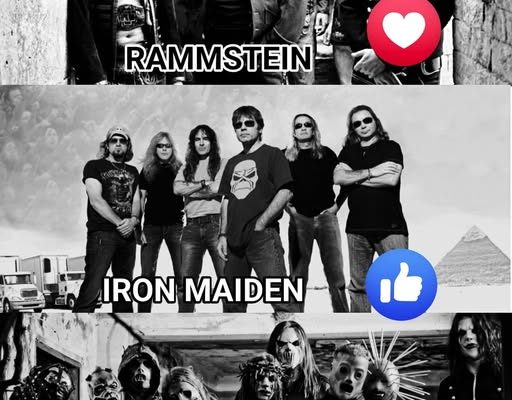When it comes to heavy music, there are certain names that loom so large that they dominate not just the genre but the cultural fabric surrounding it. Metal has always thrived on spectacle, on pushing boundaries, on creating sounds and images that refuse to blend into the mainstream. Yet even within this world of larger-than-life personas and thunderous riffs, there are bands that transcend the scene and become legendary. Among them, three names consistently ignite the most intense discussions, fan debates, and rivalries: Rammstein, Iron Maiden, and Slipknot. Each represents not just a unique sound but an entire ethos, aesthetic, and cultural movement. Together they embody three different generations of metal dominance, each reshaping what it means to be heavy and leaving their mark on millions of fans around the globe.
Iron Maiden are often regarded as the elder statesmen of this trio, hailing from the New Wave of British Heavy Metal that redefined the scene in the late 1970s and early 1980s. Emerging from East London with galloping riffs, soaring vocals, and fantastical storytelling, they built a reputation as masters of theatrical performance and musicianship. Bruce Dickinson’s operatic voice, Steve Harris’s bass-driven songwriting, and the twin-guitar harmonies of Dave Murray and Adrian Smith carved a sonic identity that became instantly recognizable. Songs like “The Number of the Beast,” “Hallowed Be Thy Name,” and “Fear of the Dark” are not just staples of metal history; they are anthems that have united stadiums full of fans for decades. Iron Maiden’s longevity and their ability to remain both relevant and uncompromising speak to their influence. With their mascot Eddie serving as one of the most iconic figures in music imagery, Maiden built a brand that extended beyond records into comic books, video games, and a global touring empire. They are the textbook definition of legends who helped codify what heavy metal looks and sounds like.
Rammstein, by contrast, represent a different kind of beast. Formed in Berlin in 1994, they emerged from the ashes of reunified Germany with a sound that fused industrial metal with a distinctly Teutonic flair for discipline, precision, and provocation. While Iron Maiden conjured fantastical narratives of mythology and history, Rammstein took on the darker, more uncomfortable themes of human existence—violence, politics, sexuality, and the grotesque. Sung almost exclusively in German, their lyrics have never been a barrier to international success; in fact, the harshness and unfamiliarity of the language only enhanced their mystique. Their concerts are notorious spectacles of fire, pyrotechnics, and surreal theatrics. To see Rammstein live is to witness a band that understands the true scale of performance art. From Till Lindemann’s imposing stage presence to the mechanical rhythms that feel more like the march of war than traditional rock beats, Rammstein are a force of raw impact. Tracks like “Du Hast,” “Sonne,” and “Ich Will” have become rallying cries for fans across continents. Where Iron Maiden embody classic heavy metal heroism, Rammstein project something more sinister, more modern, and more industrial—an almost dystopian vision of what metal can be.
Slipknot, the youngest of the trio, burst onto the scene in the late 1990s with a ferocity that was unmatched. Emerging from the American Midwest, specifically Des Moines, Iowa, Slipknot injected nu-metal with chaos, rage, and theatrical horror. Nine masked members clad in matching jumpsuits, pounding percussion, downtuned guitars, and guttural vocals combined into a live experience that bordered on violent catharsis. Their self-titled debut and sophomore release Iowa redefined what extremity could mean in mainstream music. Corey Taylor’s versatility as a vocalist—shifting from growls and screams to melodic choruses—gave the band a depth that separated them from their peers. Songs like “Wait and Bleed,” “People = Shit,” and “Duality” became rallying anthems for a generation that felt alienated, angry, and disillusioned. Slipknot were never just about the music; they were about channeling collective aggression into something cathartic and unifying. Their image and their sound sparked controversy, parental concern, and critical disdain, yet their impact was undeniable. Over time, they grew into a band that proved capable of musical maturity while retaining their feral edge, cementing themselves as one of the definitive heavyweights of the modern era.
When fans pit these three bands against one another in the ultimate showdown, they are not just comparing riffs or vocal styles. They are comparing philosophies. Iron Maiden represent legacy, a connection to the roots of metal and the grandeur of storytelling through song. Rammstein embody provocation, a willingness to shock and unsettle, using industrial precision to create something both brutal and artistic. Slipknot are the voice of rage, the embodiment of modern chaos, and a testament to how extreme music can resonate with mainstream audiences without losing its bite. To argue who is “better” is almost to miss the point. Each has cultivated its own mythos and following, each has built an empire that is distinctly theirs. Yet the debates rage on because fans identify so deeply with the spirit their chosen band represents.
Culturally, these bands also represent different regions and identities within the metal community. Iron Maiden are quintessentially British, steeped in the tradition of working-class grit mixed with intellectual curiosity. Their songs about historical battles, literature, and existential themes carry a sense of grandeur that reflects a very specific cultural backdrop. Rammstein are unmistakably German, their cold precision and willingness to confront taboo subjects reflecting the cultural complexities of post-reunification Europe. Slipknot are undeniably American, embodying the angst, nihilism, and aggressive individualism that surged in the late 1990s and early 2000s. Each band speaks to its roots, yet each has also transcended them, resonating with fans from every corner of the globe. It is this universality combined with local authenticity that makes them titans rather than just successful bands.
Live performances are another arena where comparisons become especially heated. Iron Maiden’s concerts are legendary for their set designs, use of Eddie, and sheer scale. They are a well-oiled machine delivering epic narratives on stage. Rammstein, on the other hand, push live production into the realm of the avant-garde, with fire cannons, flamethrowers, and twisted theatricality turning each show into a surreal experience. Slipknot’s live shows, meanwhile, thrive on intensity and chaos—stage-diving percussionists, ferocious mosh pits, and a primal sense of release that makes fans feel part of something dangerous and exhilarating. Each band commands its crowd differently: Maiden inspire awe, Rammstein provoke fascination, and Slipknot incite frenzy. The experience of attending one of their shows is as important as listening to their albums, which is why they continue to draw audiences by the tens of thousands.
In terms of commercial success, all three bands have proven that heavy music is far from niche. Iron Maiden continue to sell out stadiums worldwide and have sold over 100 million records, a staggering achievement for a band that has always stuck to its artistic guns. Rammstein have become Germany’s biggest musical export, headlining massive festivals and selling millions of albums despite singing in a language rarely used in global pop music. Slipknot, once dismissed as a gimmick, now stand as one of the most commercially successful metal bands of the 21st century, their albums topping charts and their festival Knotfest becoming a global brand. Each has found a way to turn intensity into sustainability, ensuring their place at the top of the metal hierarchy.
The question of influence also looms large in any discussion of these bands. Iron Maiden inspired generations of musicians, from thrash metal pioneers like Metallica to countless younger bands across power, progressive, and even extreme metal. Their blueprint of combining melody with heaviness remains one of the most emulated formulas in rock history. Rammstein carved out a space for industrial metal that combined shock value with accessibility, influencing not just other German acts but artists around the world who wanted to blend performance art with music. Slipknot ignited a wave of nu-metal and metalcore acts, their mix of brutality and mainstream hooks showing that uncompromising aggression could achieve mainstream dominance. Without these three bands, the shape of modern heavy music would look radically different.
Ultimately, the showdown between Rammstein, Iron Maiden, and Slipknot is less about crowning a single champion and more about celebrating the diversity of what metal can be. They each embody different answers to the same question: what does it mean to channel raw emotion into sound? For Maiden, it is about crafting epic tales of struggle, triumph, and human resilience. For Rammstein, it is about provoking thought and pushing boundaries through shock and precision. For Slipknot, it is about giving voice to anger, alienation, and collective catharsis. All three are titans, not because they dominate the same territory, but because they rule different kingdoms within the same empire. Their rivalry lives on not as enmity but as a reflection of the passion their fans bring to the table, the endless debates in forums, pubs, and social media threads where each side makes their case with almost religious fervor. And that, in many ways, is the true magic of metal. It thrives on devotion, on the fire of loyalty, and on the refusal to compromise. Rammstein, Iron Maiden, and Slipknot embody that spirit, and whether you favor the galloping anthems, the industrial infernos, or the chaotic assaults, one truth remains unshakable: these bands are not just part of the genre—they are the genre’s living, breathing titans.



